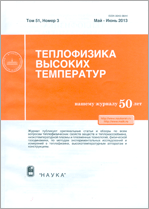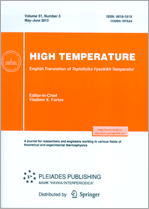|
|
Teplofizika vysokikh temperatur, 2011, Volume 49, Issue 4, Pages 616–626
(Mi tvt514)
|
 |
|
 |
This article is cited in 1 scientific paper (total in 1 paper)
High Temperature Apparatuses and Structures
Conjugated Heat and Electrophysical Characteristics of K-Phase Films on Electrode Walls of the Channel of an Aluminum–Hydrogen MHD Generator at High Thermal and Electric Parameters
V. I. Zalkind, S. S. Shchigel'
Institute for High Temperatures, Russian Academy of Sciences, Moscow
Abstract:
The utilization of aluminum as an intermediate energy carrier with subsequent production of high-
temperature hydrogen in reactions of hydrothermal oxidation makes it possible to build high-performance thermal-power cycles with an MHD generator, with a real prospect for their utilization in emergency and high-peak power plants [1]. One of the main problems of efficient operation of an MHD generator channel is the deposition of K-phase in the form of conducting melt films of $\mathrm{Al}_2$$\mathrm{O}_3$ on the fire surface of MHDG channel walls. As this takes place, there are leakage currents through the melt films in the induced transversal and Hall fields, which are accompanied by Joule heat-evolution. The peculiarities of formation, flow, and thermal regime of such a film on the fire walls of MHDGs in the induced Hall and transversal fields were studied in this connection, as well as the peculiarities of current flow with regard to temperature dependencies of the conduction and the viscosity of the $\mathrm{Al}_2$$\mathrm{O}_3$ melt. The results of investigation make it possible to estimate the influence of such films on aluminum–hydrogen MHDG performance.
Received: 25.03.2010
Citation:
V. I. Zalkind, S. S. Shchigel', “Conjugated Heat and Electrophysical Characteristics of K-Phase Films on Electrode Walls of the Channel of an Aluminum–Hydrogen MHD Generator at High Thermal and Electric Parameters”, TVT, 49:4 (2011), 616–626; High Temperature, 49:4 (2011), 598–607
Linking options:
https://www.mathnet.ru/eng/tvt514 https://www.mathnet.ru/eng/tvt/v49/i4/p616
|


|





 Contact us:
Contact us: Terms of Use
Terms of Use
 Registration to the website
Registration to the website Logotypes
Logotypes








 Citation in format
Citation in format 
